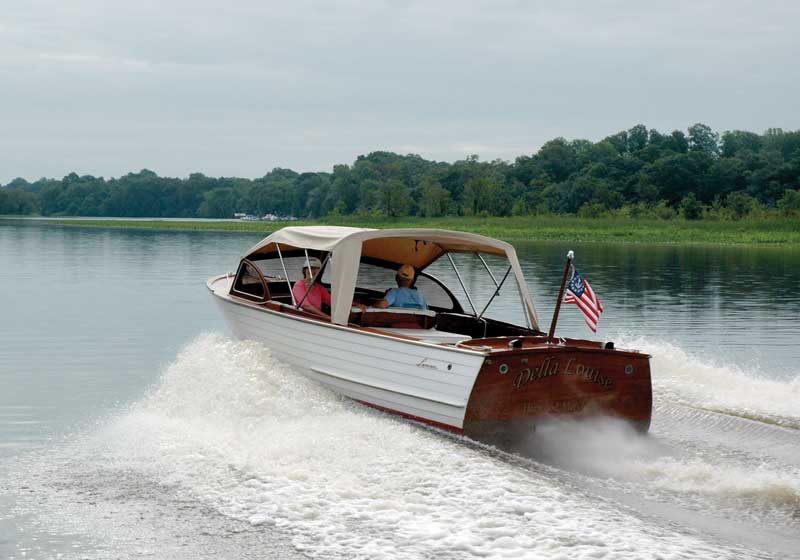We were running at 3000 rpm on the engine’s tach, and all five of us had a cushioned seat on this Lyman 23. The waves were calm, the sun was out, and boat traffic was light. We were on a cruise to Chesapeake City after launching at Turner Creek Landing in Kennedyville, MD.

Chesapeake City is on the C&D Canal, which connects the Chesapeake Bay with the Delaware River. The Canal is about 14 miles long, and the town is just a few miles in from the C&D’s western edge at the top of the Bay. Our trip one way was a cruise of about 20 miles from the launch ramp.
We all enjoyed a comfortable ride from this Lyman’s round chine, clinker-built hull. Clinker-built boats are constructed so that their wood planking edges essentially overlap the top of the plank below it. All of those proud plank edges create additional lift as the boat planes on top of the water. They also make for a drier ride, especially if you’re sitting in the back of the boat.
Clinker-built boat construction dates back to the Vikings. The planks are fastened with screws, and clinch-nailed between the frames. This fastening and planking method allows for a slight flex in each board joint, which softens the boat’s ride.
Three of us sat comfortably on the full-width rear seat and weren’t disturbed at all by the wave action. The skipper and boat owner, Ray Glenn, backed off our cruising rpm for only the largest cruiser wakes. A small course adjustment handled the other wakes from fellow boaters.
Cruising in a classic boat is a nice and welcoming experience. As usual, at the launch ramp others commented on our classic. It seems that fellow boaters recognize a well-running boat that’s been lovingly maintained for six generations.
This Lyman is a 23-foot by eight-foot, four-inch wooden boat, weighing approximately 1.65 tons. She has about a 50-gallon gas tank. Freeboard forward is about four feet, with approximately three feet aft.
Under the foredeck is a small, padded cushion sleeping area, so she’s nicknamed “a sleeper.” Another feature is a folding snap-on, Navy-style top for sun protection. I especially like the dual opening sections of its windshield that lets in a great breeze on a hot summer’s day.
This past winter the boat was refreshed on multiple levels. It got a long block as the replacement engine onto which all the accessories from the existing engine (such as the starter and alternator) were added. In this case both the prior engine and the new long block are GM/Chevy 350 engines. Ray did the work himself.
By far the biggest job fell to Will Ruhland of Distinctive Finishes in Delmar, DE. Will delivered an impeccable, lustrous re-varnish job that just sparkles. It’s truly an excellent example of Will’s signature workmanship.
The hull sides were also refinished in Lyman white, while the boot top stripe, bottom paint, and selective hardware replacement/re-chroming took place, adding to the looks of this top-notch classic boat. Glenn did all of this work himself. On this Saturday excursion, the boat sure looked sharp to all who saw her in our group, running on the water or at the ramp.
This excursion was a joint effort organized by two sister chapters of the Antique and Classic Boat Society (ACBS): the Mid-Atlantic chapter (representing members from Pennsylvania and New Jersey) along with the Chesapeake Bay Chapter (with members attending from Maryland, Washington, DC, and Virginia). Some of the boats launched on the Chesapeake Bay; others left from Salem, NJ, and came down from the top of the C&D Canal. This event was conveniently located halfway between the two clubs.
Dining at the Bayard House waterfront restaurant in Chesapeake City was another highlight of this outing, starting with its convenient location just a block from the town docks. With Covid-appropriate seating and a creative menu, our group enjoyed unique variations on sandwiches and salads, capped with a few shared but yummy desserts.
After lunch we enjoyed a walk around the small town, where a bride and groom took photos on a perfect summer day. The cruise back to the launch ramp across flat-as-a-mirror water took about 90 minutes.
By Chris "Seabuddy" Brown